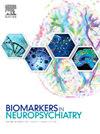Dimensions of psychosis in delirious and catatonic trauma critically Ill patients
Q2 Medicine
引用次数: 0
Abstract
Objective
We examined the effect of delirium and catatonia on psychosis symptom presentation in trauma intensive care unit (TICU) patients without previous history of serious psychiatric illness.
Design
Prospective observational cohort study at a single academic medical center TICU, enrolling adult patients with critical illness secondary to traumatic injury excluding patients with significant psychiatric history. ICU patients received once-daily DSM-5 delirium and catatonia evaluations, and Clinician-Related Dimensions of Psychosis Severity Scale (CRDPSS) assessment. Patients were grouped by delirium and/or catatonia diagnosis with Kruskal-Wallis and Pearson’s Chi-square testing of differences between groups in CRDPSS scores.
Main Results
74 patients were sorted into delirium and/or catatonia groups for the dimensions of psychosis analysis. Catatonia was common in this critically ill trauma population with 26 % prevalence. Patients with delirium and/or catatonia diagnoses had differing severities of psychosis symptoms from those with neither condition. CRDPSS total scores were significantly different between the groups (p = 0.011).
Conclusions
Further investigation is needed to explore commonalities in the mechanisms underpinning ICU psychosis and to identify specific psychotic symptom manifestations suggestive of delirium versus catatonia.
精神错乱和紧张性创伤危重病人的精神病维度
目的探讨谵妄和紧张症对创伤重症监护病房(TICU)无严重精神疾病史患者精神病症状表现的影响。设计在单一学术医疗中心TICU进行前瞻性观察队列研究,纳入创伤性损伤继发危重疾病的成年患者,排除有明显精神病史的患者。ICU患者接受每日一次的DSM-5谵妄和紧张症评估,以及精神病严重程度临床相关维度量表(CRDPSS)评估。根据谵妄和/或紧张症的诊断对患者进行分组,使用Kruskal-Wallis和Pearson卡方检验各组之间CRDPSS评分的差异。主要结果74例患者按精神病维度分为谵妄组和(或)紧张症组。紧张症在重症创伤人群中很常见,患病率为26% %。诊断为谵妄和/或紧张症的患者与未诊断为谵妄和/或紧张症的患者具有不同程度的精神病症状。CRDPSS总分组间比较差异有统计学意义(p = 0.011)。结论需要进一步研究ICU精神病发病机制的共性,并确定谵妄与紧张症的具体精神病症状表现。
本文章由计算机程序翻译,如有差异,请以英文原文为准。
求助全文
约1分钟内获得全文
求助全文
来源期刊

Biomarkers in Neuropsychiatry
Medicine-Psychiatry and Mental Health
CiteScore
4.00
自引率
0.00%
发文量
12
审稿时长
7 weeks
 求助内容:
求助内容: 应助结果提醒方式:
应助结果提醒方式:


